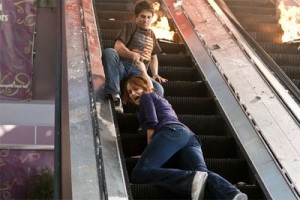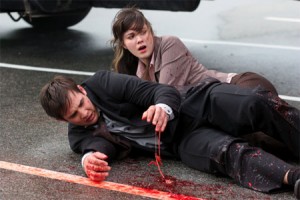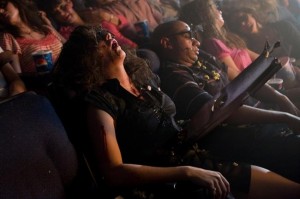The Final Destination
 It’s always tempting to dissect a movie that never had any intention of being analyzed. You can read any message you want in a slew of different films; especially if sloppy filmmaking and indecision have left the door open (as with Knowing). Surely, a director who prepared, shot, and edited his movie during a period of two years had more on his mind than simply completing the film and moving on to the next project? How could individual scenes mean absolutely nothing outside of their function as plot points and exposition? While “The Auteur Theory” posits the idea that a director’s personal stamp should be evident in everything he shoots, considering he would have such a unique and identifiable style (like Spike Lee’s floating scenes or Jonathan Demme’s directing actors to stare directly into the camera), not everyone is so individualistic.
It’s always tempting to dissect a movie that never had any intention of being analyzed. You can read any message you want in a slew of different films; especially if sloppy filmmaking and indecision have left the door open (as with Knowing). Surely, a director who prepared, shot, and edited his movie during a period of two years had more on his mind than simply completing the film and moving on to the next project? How could individual scenes mean absolutely nothing outside of their function as plot points and exposition? While “The Auteur Theory” posits the idea that a director’s personal stamp should be evident in everything he shoots, considering he would have such a unique and identifiable style (like Spike Lee’s floating scenes or Jonathan Demme’s directing actors to stare directly into the camera), not everyone is so individualistic.
That’s where the idea of calling a filmmaker a hack is used; either he’s thought through the entire movie, shot by shot, trying to send whatever salient point he intends to get across, or he’s an anonymous nobody who showed up to collect his paycheck. Of course, both points of view are total exaggerations; even a movie by a “hack” is going to have evidence of human hands and a specific style to it.
 And yet, The Final Destination shows absolutely no evidence of being written by anything other than monkeys behind a typewriter or being shot by computers rendering effects. Considering the only way that this third sequel to the original was able to differentiate itself was to be shot in 3-D, it’s clear that the most important people on the set were those technicians whose expertise was in devising ways for objects to be thrown at us in the audience as we squinted to “take advantage” of the glasses we were handed on the way into the theater.
And yet, The Final Destination shows absolutely no evidence of being written by anything other than monkeys behind a typewriter or being shot by computers rendering effects. Considering the only way that this third sequel to the original was able to differentiate itself was to be shot in 3-D, it’s clear that the most important people on the set were those technicians whose expertise was in devising ways for objects to be thrown at us in the audience as we squinted to “take advantage” of the glasses we were handed on the way into the theater.
This isn’t just a boilerplate slamming of a sequel that could have been written during the middle portions of a film critic’s nap. (The Final Destination is really that mechanical.) But usually in slasher sequels, the characters are limited and two-dimensional at best. Instead, as written and performed, the characters in The Final Destination have no dimension. Not only would a viewer have a hard time remembering a character’s name from scene to scene (“the girlfriend of the hero guy, she kind of looks like a young Carla Gugino”), they literally have no character traits. Other than the one guy who is a metrosexual slut (whose name is Hunt, truly only memorable because of what a stupid pun it is), everyone else is placed in scenes for no other reason than to set up the graphic deaths.
 This approach isn’t really that much of a surprise. While the first Final Destination is a surprisingly smart, gruesome and darkly funny movie, the sequels don’t bother developing anything other than the idea that death has an actual personality. (Death enters after characters escaped a freakish disaster like a car crash or rollercoaster accident.) Even within the slim pleasures of Final Destination 2 and 3, it was clear that death was actually a character in the films and revenge was its only motive. In The Final Destination, director David R. Ellis does such a poor job of establishing any characters or plot that the death scenes (predicated on screws coming loose or on devices that topple over into something else, causing a chain reaction *) create no sense of death as a character at all. The entire raison-d’etre for these films becomes a chronology of the complex and convoluted ways that the characters die as a result of their initial escape from certain doom. The deaths in The Final Destination play as if the wind were acting up, causing scaffolding to fall on a group of people. Or an entire race track exploded because of a shoddy bench-building job by a construction company that didn’t stabilize a concrete structure.
This approach isn’t really that much of a surprise. While the first Final Destination is a surprisingly smart, gruesome and darkly funny movie, the sequels don’t bother developing anything other than the idea that death has an actual personality. (Death enters after characters escaped a freakish disaster like a car crash or rollercoaster accident.) Even within the slim pleasures of Final Destination 2 and 3, it was clear that death was actually a character in the films and revenge was its only motive. In The Final Destination, director David R. Ellis does such a poor job of establishing any characters or plot that the death scenes (predicated on screws coming loose or on devices that topple over into something else, causing a chain reaction *) create no sense of death as a character at all. The entire raison-d’etre for these films becomes a chronology of the complex and convoluted ways that the characters die as a result of their initial escape from certain doom. The deaths in The Final Destination play as if the wind were acting up, causing scaffolding to fall on a group of people. Or an entire race track exploded because of a shoddy bench-building job by a construction company that didn’t stabilize a concrete structure.
 So, tracking back in the quadrilogy, while there was always a hint in the previous films of a negative attitude toward technology, The Final Destination has nothing else going on to distract you from it (other than the suggestion that too much shame will kill you, if your swimsuit gets caught at the bottom of the pool, take it off instead of drowning,). Whether Ellis intended The Final Destination to be anything other than a product is unclear. But even Godfrey Reggio’s Koyaanisqatsi is more subtle about its anti-industrialization bent.
So, tracking back in the quadrilogy, while there was always a hint in the previous films of a negative attitude toward technology, The Final Destination has nothing else going on to distract you from it (other than the suggestion that too much shame will kill you, if your swimsuit gets caught at the bottom of the pool, take it off instead of drowning,). Whether Ellis intended The Final Destination to be anything other than a product is unclear. But even Godfrey Reggio’s Koyaanisqatsi is more subtle about its anti-industrialization bent.
Any amount of personality in The Final Destination would have distracted us. Normally the one saving grace, in even the direst Final Destination film, is the macabre humor. The Final Destination has but a sole moment of macabre humor when one character, in attempting to break the pecking death order, continuously fails at suicide. And the death scenes, other than a rather superb impaling, aren’t all that memorable and have far too much phony CGI.
Still, Ellis almost manages a scene of self-awareness. But then he isn’t able to put across the inherent joke in the material: that it’s one big safety instructional video.
 If there’s one thing that remains clear about the film, it’s that every few years, Death gets bored and goes about killing TV-friendly teenagers. And because the teen-agers’ entire worlds are made up of technological advancements, there’s nowhere they can hide to avoid Death. Maybe for Final Destination 5, the filmmakers can challenge themselves by setting the movie on an Amish farm.
If there’s one thing that remains clear about the film, it’s that every few years, Death gets bored and goes about killing TV-friendly teenagers. And because the teen-agers’ entire worlds are made up of technological advancements, there’s nowhere they can hide to avoid Death. Maybe for Final Destination 5, the filmmakers can challenge themselves by setting the movie on an Amish farm.
* It has always been clear that with the domino effect of the deaths in the Final Destination series there could be a tweak in the tone of the musical score and the films could easily play as lowbrow comedies in the style of American Pie, where the elements of the joke build in view of the audience and the humor is in the tension of the inevitable.



